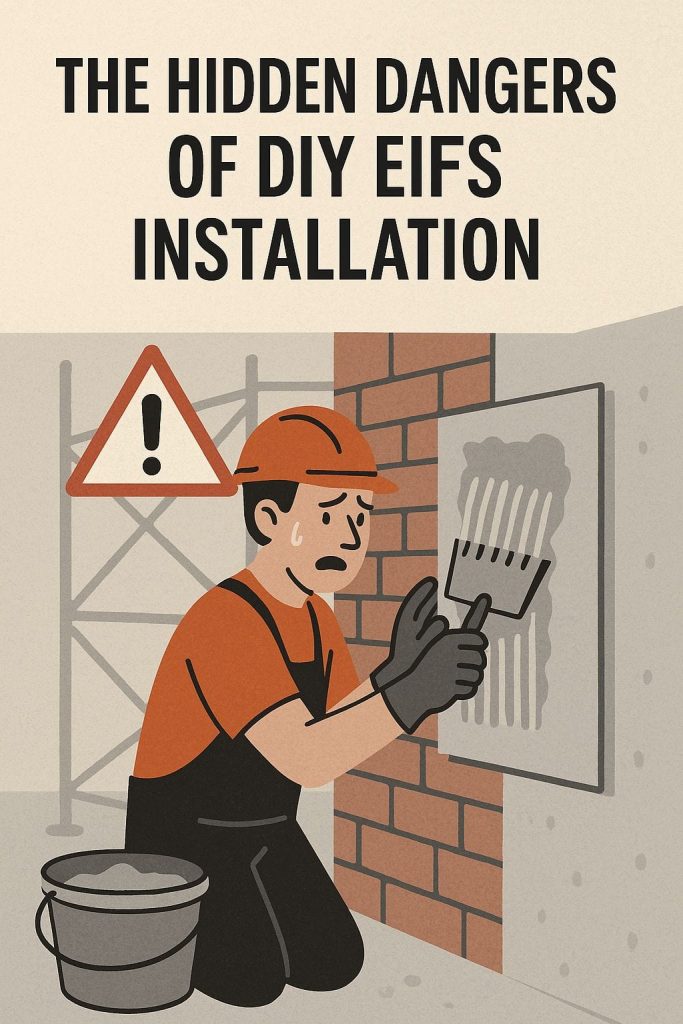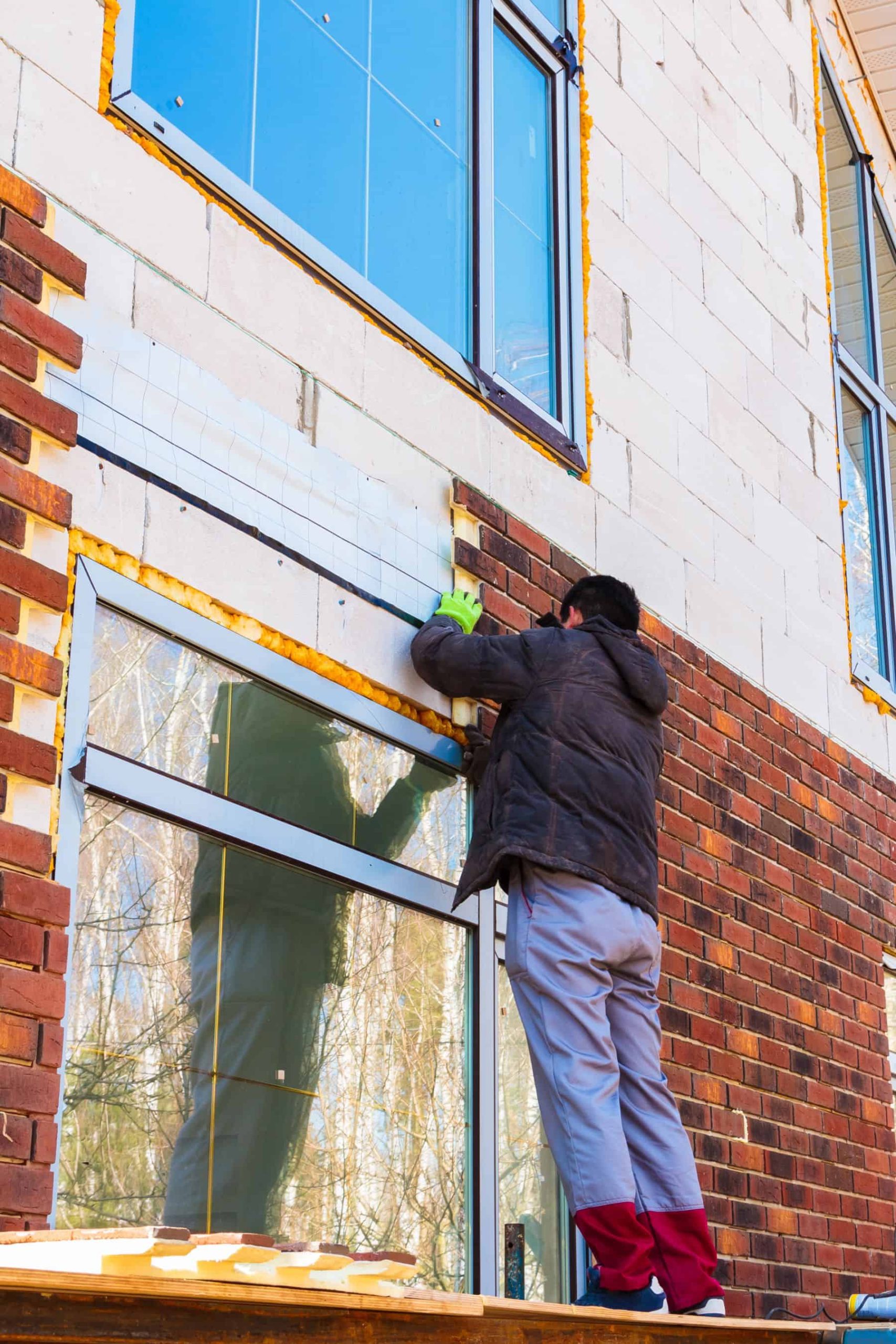Introduction: The Allure of DIY
This comprehensive article dives into the complexities and potential dangers of DIY Exterior Insulation and Finish System (EIFS) installation. It highlights the importance of professional expertise in EIFS installation to ensure a successful project that adheres to building codes, protects your investment, and delivers the benefits that make EIFS an attractive option for homeowners.
As a homeowner, it’s natural to take pride in your property and want to undertake projects that can improve its value, appearance, and overall appeal. With the rise of DIY culture, fueled by countless online tutorials and home improvement shows, more and more people are turning to their own two hands to make their homes look better. However, not all DIY projects are created equal, and some can present hidden dangers if not executed properly. One such project is the installation of an Exterior Insulation and Finish System (EIFS). In this blog post, we’ll explore the hidden dangers of DIY EIFS installation and why it might be best to leave this particular project to professionals.
What is EIFS and Why is it Popular?
A Brief Overview of EIFS
EIFS is a cladding system that provides a building’s exterior with insulation, weather resistance, and an attractive finish. It is made up of several layers, including a foam insulation board, a reinforcing mesh, and a durable finish coat. This versatile and energy-efficient system has become increasingly popular among homeowners who want to upgrade their property’s exterior while also improving its energy efficiency.
The Advantages of EIFS
Why is EIFS so popular? It has a number of advantages over traditional exterior cladding materials like stucco, brick, or wood. These include:
- Improved energy efficiency
- Versatile design options
- Durability and low maintenance requirements
- Resistance to water and moisture damage
With these benefits, it’s no wonder that homeowners are drawn to EIFS as an attractive and practical option for their homes. However, before you dive into a DIY EIFS project, let’s take a look at the hidden dangers you may encounter.
The Hidden Dangers of DIY EIFS Installation

Risk of Improper Installation
One of the most significant dangers associated with DIY EIFS installation is the risk of improper installation. The EIFS installation process is complex and requires a thorough understanding of the materials, techniques, and tools involved. In addition, EIFS must be installed in accordance with specific manufacturer guidelines and building codes to ensure its performance and durability.
What Could Go Wrong?
Improper installation can result in a variety of issues, including:
- Water intrusion: If the EIFS is not correctly sealed, water can infiltrate the system, leading to rot, mold, and structural damage.
- Insulation failure: Improper installation can compromise the insulation’s effectiveness, negating one of the main benefits of EIFS.
- Structural damage: If the EIFS system is not adequately reinforced or attached to the building’s substrate, it can fail, leading to costly repairs and potential safety hazards.
The Importance of Expertise and Experience
EIFS installation is not a beginner’s DIY project. It requires specialized knowledge and skills that can only be acquired through proper training and hands-on experience. Professionals who specialize in EIFS installation have undergone extensive training, are familiar with the latest industry best practices, and have access to specialized tools and equipment that can make a significant difference in the quality of the installation.
Why Trust the Pros?
By hiring a professional EIFS installer, you can benefit from:
- Expert knowledge of EIFS materials and installation techniques
- Experience working with EIFS systems in various climates and conditions
- Access to specialized tools and equipment for a seamless installation
- Compliance with building codes and manufacturer guidelines
- Warranty protection for your EIFS system
Potential Legal and Insurance Issues
Another hidden danger of DIY EIFS installation is the potential for legal and insurance issues. When you choose to install an EIFS system yourself, you assume responsibility for any problems that may arise from the installation. This can lead to potential legal disputes if, for example, your EIFS installation results in water damage to your home or a neighboring property. Furthermore, some insurance companies may not cover claims related to DIY EIFS installations, which could leave you on the hook for costly repairs.
Legal and Insurance Benefits of Hiring a Professional
By hiring a professional EIFS installer, you can mitigate these risks and enjoy several legal and insurance benefits, such as:
- Compliance with local building codes: Professionals are well-versed in the building codes and regulations that govern EIFS installation in your area, ensuring that your project is completed in accordance with the law.
- Liability protection: In the event of an issue related to your EIFS system, a professional installer will typically carry liability insurance that can protect you from potential legal disputes.
- Insurance coverage: Many insurance companies prefer EIFS installations completed by certified professionals, which can help ensure that your project is covered by your homeowner’s insurance policy.
The Cost of DIY EIFS Installation
The False Economy of DIY
While it’s tempting to think that a DIY EIFS installation can save you money, the hidden costs and potential pitfalls can quickly add up, negating any perceived savings. These costs can include:
- The expense of purchasing specialized tools and equipment
- The time investment required to learn EIFS installation techniques and best practices
- The risk of costly mistakes, such as water intrusion or structural damage, due to improper installation
The Value of Professional Installation
When you factor in the risks and hidden costs associated with DIY EIFS installation, hiring a professional installer becomes a more cost-effective choice in the long run. Not only can you enjoy the peace of mind that comes with a high-quality, professional installation, but you can also save time, effort, and potential headaches by avoiding the pitfalls of a DIY approach.
The Bottom Line: Think Twice Before Attempting DIY EIFS Installation
As appealing as the idea of a DIY EIFS installation may be, the hidden dangers and potential pitfalls make it a risky endeavor. From improper installation and compromised performance to legal and insurance issues, the risks far outweigh the potential benefits. By hiring a professional EIFS installer, you can ensure a successful, high-quality installation that complies with building codes, protects your investment and delivers the energy efficiency and aesthetic benefits that make EIFS such an attractive option for homeowners.
Key Takeaways
Before you jump into a DIY EIFS installation, consider these key takeaways:
- EIFS installation is a complex process that requires specialized knowledge and skills.
- Improper installation can result in water intrusion, insulation failure, and structural damage.
- Professional EIFS installers have the expertise, experience, and tools necessary to ensure a successful installation.
- DIY EIFS installations can create legal and insurance risks that are best avoided by hiring a professional.
- The cost of DIY EIFS installation can quickly escalate when factoring in hidden expenses and potential pitfalls, making professional installation a more cost-effective choice.
So before you embark on a DIY EIFS installation, think twice, weigh the risks, and consider the value of hiring a professional to help protect your home, your investment, and your peace of mind.

